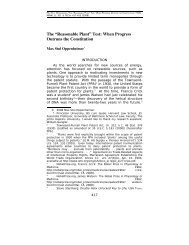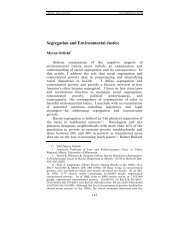An Organizational Approach to the Design of Patent Law
An Organizational Approach to the Design of Patent Law
An Organizational Approach to the Design of Patent Law
You also want an ePaper? Increase the reach of your titles
YUMPU automatically turns print PDFs into web optimized ePapers that Google loves.
6 VERTINSKY FINAL_JAD (DO NOT DELETE) 2/27/2012 2:20 PM<br />
2012] AN ORGANIZATIONAL APPROACH 223<br />
might actually alter behavior. In doing so, <strong>the</strong>y largely ignore<br />
<strong>the</strong> different mechanisms by which patents may alter behavior<br />
in <strong>the</strong> production and use <strong>of</strong> innovation. 41<br />
2. Perfect Competition as a Benchmark<br />
A second limitation is <strong>the</strong> benchmark used by traditional<br />
<strong>the</strong>ories for evaluating rule change. In evaluating <strong>the</strong> impact <strong>of</strong><br />
patents, a model <strong>of</strong> perfect competition serves as <strong>the</strong> benchmark<br />
against which o<strong>the</strong>r forms <strong>of</strong> market activity can be compared<br />
and <strong>the</strong> efficiency costs <strong>of</strong> departure from perfect competition<br />
identified. This use <strong>of</strong> a perfect world as a benchmark for<br />
comparing alternative policies limits <strong>the</strong> scope for incremental<br />
improvement and excludes considerations <strong>of</strong> feasibility in policy<br />
design. As Ronald Coase warns,<br />
[c]ontemplation <strong>of</strong> an optimal system may . . . provide techniques <strong>of</strong><br />
analysis that would o<strong>the</strong>rwise have been missed. . . . But in general<br />
its influence has been pernicious. It has directed economists’ attention<br />
away from <strong>the</strong> main question, which is how alternative arrangements<br />
will actually work in practice. It has led economists <strong>to</strong> derive conclusions<br />
for economic policy from a study <strong>of</strong> an abstract model <strong>of</strong> a market<br />
situation. . . . Until we realize that we are choosing between social<br />
arrangements which are all more or less failures, we are not likely <strong>to</strong><br />
make much headway. 42<br />
Recent efforts <strong>to</strong> look at patent law in <strong>the</strong> context <strong>of</strong> imperfect<br />
competition move in <strong>the</strong> right direction, 43 but it is clear<br />
that a more comprehensive shift in <strong>the</strong> benchmarks used for<br />
comparing policy choices is needed. Part <strong>of</strong> this shift should in-<br />
41. See, e.g., James <strong>An</strong><strong>to</strong>n & Dennis Yao, Expropriation and Inventions:<br />
Appropriable Rents in <strong>the</strong> Absence <strong>of</strong> Property Rights, 84 AM. ECON. REV. 190<br />
(1994) (examining <strong>the</strong> role <strong>of</strong> patents in enabling trade in technological information);<br />
Nancy T. Gallini & Ralph A. Winter, Licensing in <strong>the</strong> Theory <strong>of</strong> Innovation,<br />
16 RAND J. ECON. 237, 238 (1985) (“[B]y protecting property rights, patents<br />
here open <strong>the</strong> market for trade in technological information.”); Robert P.<br />
Merges, Expanding Boundaries <strong>of</strong> <strong>the</strong> <strong>Law</strong>: Intellectual Property and <strong>the</strong> Cost<br />
<strong>of</strong> Commercial Exchange, 93 MICH. L. REV.1570, 1590–91 (1995) (discussing<br />
how IP rights can reduce transaction costs).<br />
42. Ronald H. Coase, The Regulated Industries: Discussion, 54 AM. ECON.<br />
REV. 194, 195 (1964).<br />
43. Herbert J. Hovenkamp, The Intellectual Property-<strong>An</strong>titrust Interface<br />
(U. Iowa Legal Studies, Research Paper No. 08-46, 2008), available at<br />
http://ssrn.com/abstract=1287628 (<strong>to</strong> access article, select One-Click Download)<br />
(stressing <strong>the</strong> importance <strong>of</strong> evaluating IP laws within specific market<br />
contexts); Mark A. Lemley, A New Balance between IP and <strong>An</strong>titrust, 13 SW J.<br />
L. & TRADE AM. 237 (2007) (arguing for <strong>the</strong> importance <strong>of</strong> evaluating rules<br />
such as private property orderings within <strong>the</strong>ir market context and using different<br />
forms <strong>of</strong> regulation <strong>to</strong> ensure <strong>the</strong> competition needed <strong>to</strong> make <strong>the</strong> rules<br />
effective).






